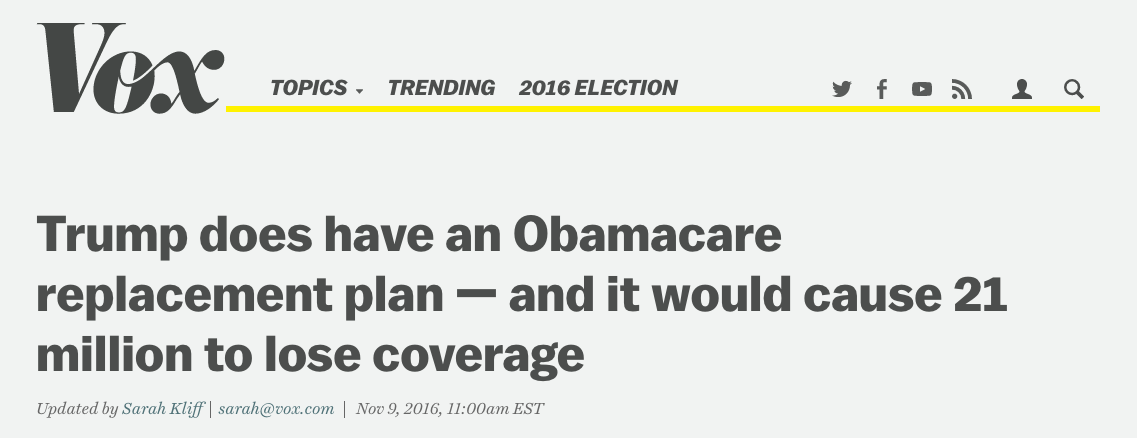
Following Trump’s election last week, pundits initially focused on the failings of the polls, the populace, and the president-elect. Next came the gracious and conciliatory words of President Obama, Hillary Clinton, and Donald Trump. But after a night of calm, rioters took to torching the streets. When daylight broke, so too did the onslaught of tears, safe-zones, and counseling sessions—as well as ridicule for the participation-trophy generation.
Police Calm Millennial Protesters By Handing Out Participation Trophies https://t.co/JPOnB2Qy00 pic.twitter.com/veXrHHdGkJ— The Babylon Bee (@TheBabylonBee) November 10, 2016
Meanwhile politicians, policy wonks, and political junkies moved on to the substantive consequences of Trump’s election. Here, one domestic issue has dominated the chatter: the repeal and replacement of Obamacare. (The future of the Supreme Court came in close second.)
With Republicans set to control the federal legislative and executive branches next year, the hyperbole of the last six years has soared to new heights:

Others have tried to ground the discussion in reality, focusing on the details of the most comprehensive replacement plans floated to date: Speaker Paul Ryan’s “A Better Way,” and Avik Roy’s “Transcending Obamacare.” Those plans both provide market-based approaches to comprehensively overhaul the health care system in America, while also addressing the numerous (and now abundantly-clear) problems of Obamacare.
Why Our Health-care Solutions Are Imperfect
While avoiding many of the defects of Obamacare, Ryan and Roy’s plans both have two fundamental and inter-related flaws: first, they focus on health coverage and not health care.
Second, they fail to take into account that a large number of Americans are too dysfunctional to benefit, as intended, by the proposals. But for the second fact, providing truly affordable health coverage might equate to obtaining health care. But given today’s culture, any proposed reform to our health care system must take into account the limitations of the populace it will serve.
Politicians and policy wonks are often too far removed from true dysfunction to understand how pervasive it is, and how it prevents even the most perfectly devised plan from succeeding as intended. Speaker Ryan somewhat recognized his disconnect when he apologized earlier this year for the “maker” vs. “taker” dichotomy he had used during his 2012 vice-presidential run:
“There was a time when I would talk about a difference between ‘makers’ and ‘takers’ in our country, referring to people who accepted government benefits. But as I spent more time listening, and really learning the root causes of poverty, I realized I was wrong. ‘Takers’ wasn’t how to refer to a single mom stuck in a poverty trap, just trying to take care of her family. Most people don’t want to be dependent. And to label a whole group of Americans that way was wrong. I shouldn’t castigate a large group of Americans to make a point.”
However, the people Speaker Ryan was likely listening to when he had this epiphany probably weren’t the truly dysfunctional citizens. These are the individuals suffering from severe mental illness, drug or alcohol addicts, or run-of-the mill adults who lack the basic skills to manage their own affairs and that of their families—much less reach out to a politician who had insulted them.
Speaker Ryan and other politicians residing in the D.C. bubble are unlikely to have seen such lives up close and personal. When they do, it isn’t a pretty picture.
Hillary Clinton in an apartment in East Harlem really just says everything. pic.twitter.com/Lm0ja2NXiv— Sarah A. Harvard (@amyharvard_) April 15, 2016
Dysfunction and Addiction Stymie Many Americans
Raised in rural Wisconsin in a trailer park, I grew up alongside a pretty representative sampling: the alcoholic divorced mother on my paper-route who regularly failed to pay the $2.10 fortnightly charge; the older man suffering from mental illness (a severe hoarder and a pedophile); young Tony, who appeared every few months after being removed from his home and placed with his grandfather; the trio of toddlers living next door with their respective mothers—three teenage sisters—and five other relatives; and my best friend Kim, whose parents were functioning alcoholics who could empty a carton of cigarettes in two days flat.
Later, when attending college, I lived in inner city Milwaukee, a few blocks from where Jeffery Dahmer targeted his victims. Between my sketchy neighborhood and my daily bus ride to and from my part-time job, I saw close-up the urban analogue. And while I’m now a suburbanite, I still get glimpses of this dysfunction, such as the meth-mouth manual laborers our contractor hired to install gutters.
An appropriate health care plan, even if fully or nearly fully subsidized, will be beyond these people’s capabilities. Likewise, providing tax credits to offset the cost of privately purchased insurance will be lost on the transient worker who already lacks the knowledge and wherewithal to claim the Earned Income Tax Credit. Signing up for Medicaid might be easier, but that does not translate into health care: beyond the limited number of doctors willing to accept the low reimbursement rates, Medicaid recipients must have it within their skillset to seek out and find a doctor.
Many cannot, which is why they do not regularly obtain preventative care and why, when sick, they end up in the emergency room. In fact, 25 percent of children in foster care do not receive the required check-ups. And these are children in the charge of individuals cleared by the government as appropriate caregivers and provided medical coverage. Consider, then, the care they would be receiving if they remained in the homes of their dysfunctional birth parents.
So by all means, repeal Obamacare. Replace it with provisions theoretically sound. But do not judge the success of the replacement legislation on the number of people with health care coverage, whether private or governmental. That tells us nothing about health care or health outcomes. Rather, we must address the problem of the lack of health care or poor health outcomes separately and outside of the insurance and Medicaid structure. Here are a few ways to do so.
We Don’t Need Health Marketing—We Need Health Markets
Many health conditions and illnesses are preventable. Then-Congressman Ryan highlighted this point in his predecessor legislative initiative, The Patients’ Choice Act, writing:
“[F]ive preventable chronic diseases (heart disease, cancer, stroke, chronic obstructive pulmonary disease, and diabetes) cause two-thirds of American deaths while 75 percent of total health expenditures are spent to treat chronic diseases that are largely preventable. In government programs, the problem is even worse with chronic disease spending consuming 96 cents of every Medicare dollar and 82 cents of every Medicaid dollar.”
Preventing disease by lifestyle choices and immunizations would greatly reduce health care costs. Private insurers use “wellness programs” to promote preventative care, weight loss, and smoking cessation programs; they offer reduced premiums or other rewards when certain goals are met. But similar programs are not feasible for those on Medicaid. Nor will relying on advertising campaigns “designed by social marketing professionals, on health promotion and disease prevention” work.
Advertising might make Nike popular, but that’s because—in the words of my 80’s youth—those shoes are “sweet.” But you know what else is sweet? Ho-Ho’s. And do you know what you can buy quickly and easily in the inner city at the “grocery” stores that flank nearly every block corner? Hostess products. Not produce. All the advertising in the world will not provide access to healthier food options and even if it did, that will not change eating behaviors.
Fight Food Deserts, And Create Health Oases
Lower-class Americans do not need more marketing. They need more markets: vast areas of the inner cities and rural areas are “food deserts.” “America’s Worst 9 Urban Food Deserts” highlighted this problem:
[T]he United States Department of Agriculture reports that about 23.5 million Americans currently live in food deserts, including 6.5 million children. Typically, food deserts are defined by 1) the lack or absence of large grocery stores and supermarkets that sell fresh produce and health food options; and 2) low-income populations living on tight budgets. These food deserts are also signified by high levels of obesity, diabetes and cardiovascular disease in the community, which result from residents buying their food from corner stores that sell processed foods, and plentiful fast food options.
The solution is to create health oases. Unfortunately, Democratic control of large cities has often led to resistance to “big-box” retailers. That’s code for non-union superstores, such as Wal-Mart. The government must remove the barriers that prevent large grocery stores from opening in urban areas and adopt business-friendly policies to encourage them to do so. Detroit has recently done this to great benefit with the regional super-store Meijers, which is now looking to open a third store within the city. Not only does this provide access to healthy food options, it also provides employment opportunities that are lacking in the inner city.
Promoting the expansion of large grocery stores within the inner city will also greatly reduce the fraud that is rampant in the government food stamp (now called SNAP benefits) and WIC programs. Large corporate-run grocery stores have in place internal controls that prevent cashiers from trading government benefits for cash, ineligible items (alcohol, cigarettes), and even counterfeit apparel. It is the corner stores, owned and run by individuals or families and with unchecked access to cash, that have the means to misappropriate government funds. Over the summer, the Chicago Tribune wrote on this phenomenon in its article “Why Food Stamp Fraud is ‘Fairly Rampant’ at Corner Stores in Some Chicago Neighborhoods.”
Large grocery stores provide yet another advantage in urban areas: they often have in-store pharmacies, which have the capability to provide vaccinations. Some states also allow nurse practitioners working out of pharmacies to prescribe basic antibiotics for common conditions, such as ear infections and strep throat. Further legislation to encourage the expansion of store-run pharmacies and access to nurse practitioners will further assure health care access, making such super-stores truly health oases.
Fund Crisis Pregnancy Centers
No, this is not about abortion. It is about health and health care. Pro-“choice” advocates regularly accuse pro-lifers of caring only about the baby—not the mother—and then only until the baby is born. While that might make a pithy talking point, it bears no resemblance to reality. Most crisis pregnancy centers offer a wide-range of services, from pregnancy testing, ultrasounds, counseling, goal setting, prenatal care or referrals, parenting classes, and “reward” programs by which moms can earn necessary baby and household items. Oftentimes, counselors end up serving as birth coaches for women abandoned by the father and their family. And these relationship and services continue long after the baby is born.
What better place, then, to assure women and children obtain preventative care and nutritional guidance? Rather than dump more money into the Medicaid system, which has shown no better results for recipients than the uninsured have, we should shift funding to states and experiment with a new approach: providing grants to crisis pregnancy centers.
These grants could fund the hiring of nurse practitioners, who could see children while parents work with goal counselors. And parents could earn “points” or rewards for meeting certain targets, such as obtaining routine vaccinations or not smoking for two weeks. Stop funding more government public service announcements, and instead fund nutritional education and “rewards” implemented during parenting classes. And fund smoking cessation programs out of the centers. Many centers are already doing some of these things, with great results.
The Women’s Care Center is one such center. Formed in 1984 in South Bend, Indiana by Dr. Janet Smith, the Women’s Care Center now serves women in eight states. (I served on the Women’s Care Center Board of Directors and as the Treasurer for seven years.) A recent newsletter showcases one example of how crisis pregnancy centers can achieve what the government cannot:

The Federalist highlighted another pro-life center, Turning Point, on Monday in its piece by Jay Hobbs. As Hobbs explained, “Started in October 2010, Turning Point opened as a fully medical clinic, with ultrasound and STD/STI testing, in addition to material aid that meets the needs of a city where 30 percent residents live at or below the federal poverty rate—twice the national average.”
Hundreds, if not thousands, of similar crisis pregnancy centers already exist throughout the country. These centers have the infrastructure and experience—and more importantly, the relationships that government bureaucrats cannot forge—necessary to assure that health coverage translates into health care and healthier outcomes.
Promote Mental Health Policing
Just as the Women’s Care Center and Turning Point model how crisis pregnancy centers can reach at-risk populations, the San Antonio police department’s mental health squad showcases a new and ideal prototype for reaching the mentally ill. NPR featured this unique program in its piece “Mental Health Cops Help Reweave Social Safety Net in San Antonio.” As NPR explained, select officers receive Crisis Intervention Training; when a 911 call comes in involving a mental health emergency, those officers are dispatched.
But there is more: San Antonio built a Restoration Center, which is a separate facility that offers “a full array of mental and physical health services.” According to NPR, “[m]ore than 18,000 people pass through the Restoration Center reach year, and officials say the coordinated approach has saved the city more than $10 million annually.”
This approach should be mirrored throughout the country to address not just severe mental illness, but also the escalating problem of drug addiction. Addicts and those suffering severe mental illness—even if they are competent enough to obtain health coverage—do not have it within their means to access health care. And as Dallas Police Chief David Brown said after the murder of five of his officers: “We’re asking cops to do too much in this country. We are. Every societal failure, we put it off on the cops to solve. Not enough mental health funding, let the cops handle it.”
While the police will always be our front line of defense, with proper training and the funding to address the health care needs of addicts and the severely mentally ill, over time, the demands will be less. And more people in need of health care will receive it in an appropriate setting—and not in prison.
A Health Coverage Plan Can’t Solve All Our Problems
As the debate continues over Obamacare’s appropriate replacement, politicians and policy experts should not pretend that a perfect plan can reach all segments of our society. Congress should instead recognize that health “coverage” is an imperfect proxy for health “care” and “outcomes,” and refocus a portion of its attention and funding on policies and programs that provide health care to the severely mentally ill, the addicts, and dysfunctional members of society.
This approach will also go a long way toward providing employment opportunities, combatting fraud, reforming the criminal justice system, and assuring our first responders have access to the resources they need when confronted with impossible situations.









